Dunalastair Water In Spring
- Details
- Published on Thursday, 27 July 2006 11:06
- Written by Brian Tulloch
 Nestling in between the lochs of Tummel and Rannoch lies Dunalastair water. This unique place has everything that an angler could wish for in a trout loch: set in beautiful surroundings with the mighty Schiehallion to the south and Beinn a’ Chuallaich to the north.
Nestling in between the lochs of Tummel and Rannoch lies Dunalastair water. This unique place has everything that an angler could wish for in a trout loch: set in beautiful surroundings with the mighty Schiehallion to the south and Beinn a’ Chuallaich to the north.
The shores are surrounded by natural woodlands which play host to an abundance of rare Scottish wildlife, with pine martens, red squirrels, lesser spotted woodpeckers to name but a few. Ospreys fish on the loch and it still amazes me how these fantastic birds can see fish swimming in the water below from such a great height. Then of course there are the immense trout that inhabit this lovely water. Brownies that are wild in every sense of the word and that can hit your fly so ferociously, at times, that you don’t know what's hit you. 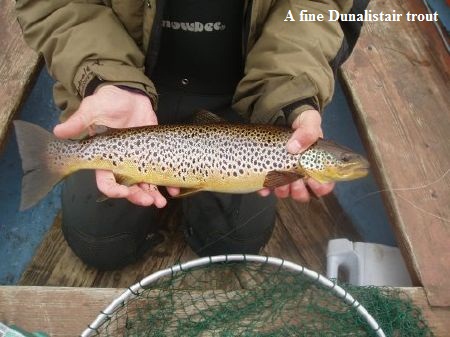
It’s refreshing to fish on a loch where nature still holds firm without any interference from man. At least that is how it looks. Despite Dunalastair's totally natural appearance, it is in fact man made. The Tummel system was impounded for hydro electric power in the 1930’s and Dunalastair is the result of part of the river being flooded in 1933. The old river bed runs through the loch and there is a steady current running down the loch the whole time. Apart from the riverbed itself, the rest of the loch is shallow and care must be taken not to run aground on the numerous tree stumps that lurk just beneath the surface.
The shallow nature of this loch means there is an abundance of aquatic insect life, and the Dunalastair trout take full advantage of this, growing to a considerable size on the plentiful food supply available to them. Of course like all waters containing trophy brown trout, it can be hard, bloody hard, but perseverance usually pays off, and sometimes with spectacular results.
It takes time to build up a picture of where to fish on this water. It can be frustrating to the newcomer, running aground on tree stumps and shallow bars, but after an outing or two the loch starts to reveal some of her secrets. These are only discovered after careful exploration. Having said all that, on our first outing we caught trout of 4.5 and 3.5 lbs which wasn’t frustrating at all, but when we returned the following day, we thought that all we had to do was repeat the process. How wrong can you be? One 8oz fish for the whole day! We were still on a high from the fish of the previous day, and perhaps the celebratory drinks the night before didn’t help our performance. 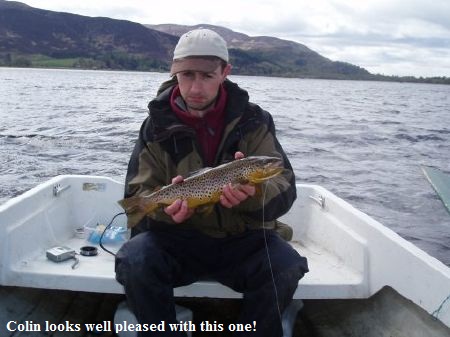
The east end of the loch is relatively clear of obstacles compared to the west. There is an old submerged wall running across the loch to the east of the boat moorings, and this area produces its fair share of trout, although it can be difficult to cover depending on wind direction. Where the river leaves Dunalastair can also be worth a drift or two and this area produced my biggest fish of 2004, a dark trout of 4 ¾ lb that I hooked on a dour April day in the late afternoon. My boat partner Colin and I had fished hard all day without so much as an offer, when my short shank ace of spades was seized by this obviously large trout, which proceeded to take me down to the backing before making a series of heart stopping leaps in the air. Colin said he could see the colour drain from my face, and I must admit that my heart was racing, knowing that I had the trout of a lifetime on the end of my line. You know what it’s like when you hook a big fish, the fear of loosing it at the net is almost unbearable, but after a lengthy tussle the prize was mine to admire, photograph and return to fight another day. This is a typical example of what can happen on this enigmatic loch and was also a lesson learned in not throwing in the towel, but persevering and fishing on.
I must admit however, that my favourite area of the loch is the west end. This area is home to the Dunalastair yellow belly. These are the trout that I dream about the night before a visit. The most magnificent brown trout I have ever seen, broad backed, as heavily spotted as a leopards, and of course with golden yellow bellies. 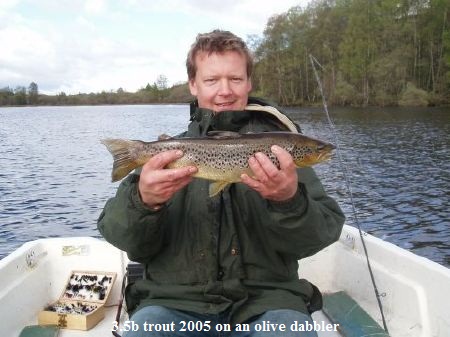 These fish can be found in shallow water as long as there is the sanctuary of deeper water close at hand. There are shallows near the river bed and deeper pockets among the tree stumps and also around the many half submerged bushes and trees. I well remember rowing up the extreme shallows at the point where the river enters the main body of the loch. It was our intention to row up this shallow water and then drift down the river bed fishing the deeper water. As we rowed up, we disturbed several huge trout that shot off like torpedoes in inches of water. At first we thought these fish were pike when we saw their huge backs out of the water, but they were brownies all right, feasting on a constant trickle of hatching olives. This was another couple of lessons learned, firstly you can find trout in surprisingly shallow water, and secondly clumsy boat handling will scare off any half decent trout into the abyss, never to be seen again.
These fish can be found in shallow water as long as there is the sanctuary of deeper water close at hand. There are shallows near the river bed and deeper pockets among the tree stumps and also around the many half submerged bushes and trees. I well remember rowing up the extreme shallows at the point where the river enters the main body of the loch. It was our intention to row up this shallow water and then drift down the river bed fishing the deeper water. As we rowed up, we disturbed several huge trout that shot off like torpedoes in inches of water. At first we thought these fish were pike when we saw their huge backs out of the water, but they were brownies all right, feasting on a constant trickle of hatching olives. This was another couple of lessons learned, firstly you can find trout in surprisingly shallow water, and secondly clumsy boat handling will scare off any half decent trout into the abyss, never to be seen again.
There are several good drifts down the centre of the loch. These are the ones that are difficult to locate, but as a rule if you are drifting over shallows with deeper pockets of water among them, then you are in good water. The south shore is better avoided, Colin and I ventured over there on our first ever visit and ran into all sorts of problems, running aground on tree stumps and shallow bars. It could well be there is good water over there, but we haven’t been there since that first trip, mainly because there’s more than enough accessible water elsewhere. One of the beauties of fishing this place, is it has so many secret drifts that are either stumbled upon by chance or are discovered by exploration. The more frequently you fish this water, the more knowledge you will gain.
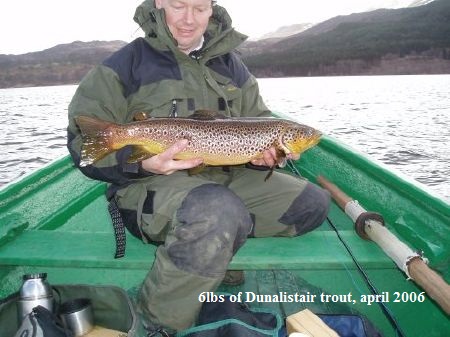 From the start of May there can be fantastic olive hatches. Trout can be seen rising all over the loch, dispelling any myths about the trout staying in the sanctuary of the river bed during the day, and only venturing into the shallows at night. I think there may be some truth in this theory during the high summer months when the water is warmer, but at this time of the year the trout are spread out and can be found in the water as described earlier. Adult olives sail down the river into the main body of the loch, and the trout are only to happy to intervene, especially at the start of the hatch when there is just a trickle coming off. Once the hatch is really under way, I suspect that most of the activity takes place below the surface with trout intercepting ascending nymphs on their way to the surface, or at the surface before they hatch. When we do opt for dry fly Colin has developed an excellent imitation. Tied with an olive flexi floss body and cdc wing. this fly was originally tied for our local river, The Avon where it has caught Colin literally hundreds of fish and has proved to be equally effective on lochs, taking fish as far north as The Loch Of St Johns. I prefer to fish sub surface during an olive hatch, and Stan Headley's slim line dabblers have proved their worth, along with pheasant tail and wire nymphs.
From the start of May there can be fantastic olive hatches. Trout can be seen rising all over the loch, dispelling any myths about the trout staying in the sanctuary of the river bed during the day, and only venturing into the shallows at night. I think there may be some truth in this theory during the high summer months when the water is warmer, but at this time of the year the trout are spread out and can be found in the water as described earlier. Adult olives sail down the river into the main body of the loch, and the trout are only to happy to intervene, especially at the start of the hatch when there is just a trickle coming off. Once the hatch is really under way, I suspect that most of the activity takes place below the surface with trout intercepting ascending nymphs on their way to the surface, or at the surface before they hatch. When we do opt for dry fly Colin has developed an excellent imitation. Tied with an olive flexi floss body and cdc wing. this fly was originally tied for our local river, The Avon where it has caught Colin literally hundreds of fish and has proved to be equally effective on lochs, taking fish as far north as The Loch Of St Johns. I prefer to fish sub surface during an olive hatch, and Stan Headley's slim line dabblers have proved their worth, along with pheasant tail and wire nymphs.
We have had some great sport even when there wouldn’t appear to be any fly life coming off at all. Our most successful day in 2005 was on a bitterly cold early May day with a strong north westerly wind blowing down the loch. The trout took a liking to my fat dabbler on the point and Colin’s ever faithful short shank ace of spades. We ended up with twelve for the day with many more hook ups and offers. Twelve might not sound that great but believe me that's good for this water. The biggest fish of the day was around the 3 ½ lb mark. That fish really hit the fly hard. I was busy cursing to Colin about the savage take I'd just missed only to discover that when I retrieved my slack line the fish was still on, and it was heading on a collision course with the boat! What a bonus it was landing a trout that I thought I’d missed. Especially when it proved to be my biggest of the season! Colin caught another two 2. ½ lb beauties that day making for a memorable days sport.
An electric outboard is a worthwhile investment as the boats aren’t the best in the world from a rowing point of view. Not only does the outboard save your back, it keeps the boat noise down to a minimum. As I mentioned earlier, noisy boat handling will scare away trout never to be seen again, such is the shallow nature of the loch. Colin and I take along two batteries, because inevitably the first battery will run out of steam at some point. There's nothing worse than having to start rowing in the late afternoon after you've been used to being propelled around the loch all day. Being able to relax in-between drifts is a great boon, and allows you to save your energy for trying to extract a yellowbelly instead.
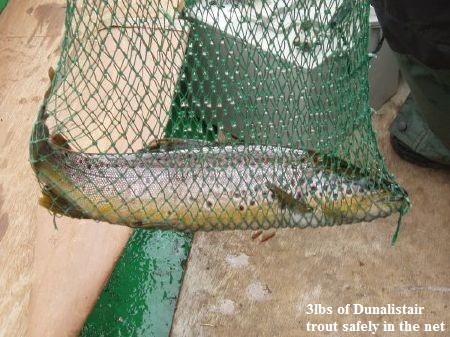 Another great way to scare off the trout in this loch is using a drogue. I wouldn't recommend you employ one, unless it's really wild, in which case it might be better to stay ashore anyway. There's also the danger that it might get caught on one of the many sub surface hazards which could lead to all sorts of problems in a high wind.
Another great way to scare off the trout in this loch is using a drogue. I wouldn't recommend you employ one, unless it's really wild, in which case it might be better to stay ashore anyway. There's also the danger that it might get caught on one of the many sub surface hazards which could lead to all sorts of problems in a high wind.
There is one thing that I ask of you. If you do decide to give Dunalastair a try, please consider returning all large trout to the water. That way they will continue to grow and give pleasure to any angler with enough patience to fish for them. These are wonderful creatures and I think a certain amount of restraint is required so we can continue to enjoy catching them in the future. Surely it is better to take a picture of these fish in all their glory, with all of their beautiful colours and markings, and return them carefully to fight another day.
Flies For Dunalastair In The Spring Months
Short Shank Ace of Spades, Fat Dabbler- this is simply an olive dabbler with a lead underbody, fished on the point. The trout in this water love it. Bibio, Kate Mclaren, Palmered March Brown, Slimline Dabbler, Olive Wire Nymph, Pheasant tail nymph, Cols olive, Zulu, Clan Chief, Half Hogs and the Bumble family.
Boat Hire contact Jim at the Loch Garry cottage Telephone 01882 632354

